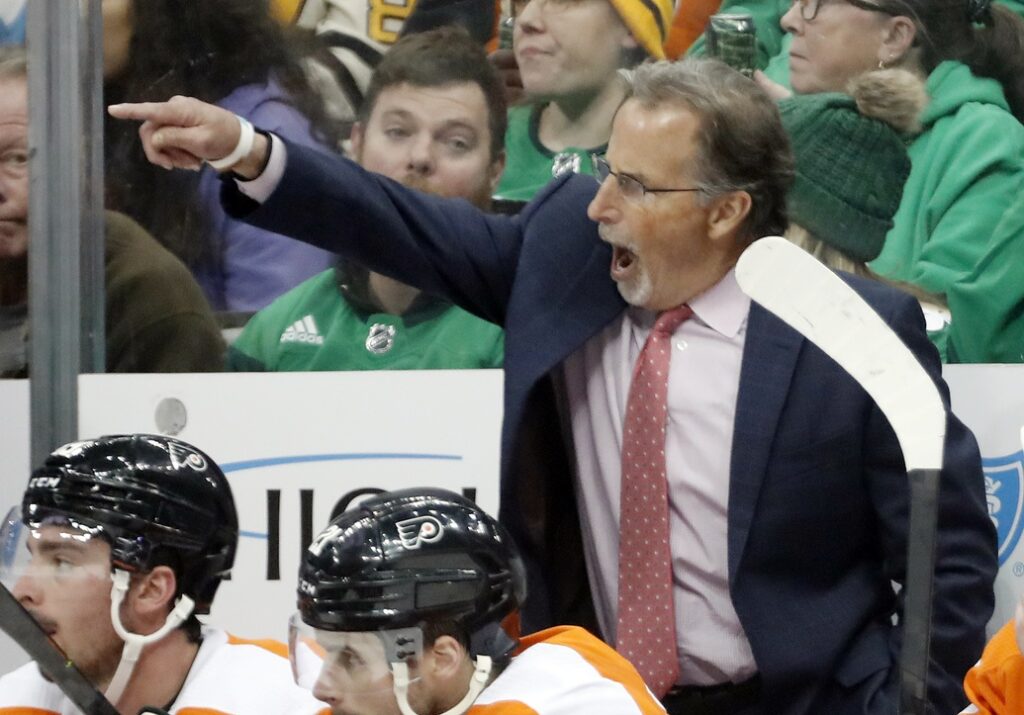
By KEVIN OKLOBZIJA
The NHL archives will forever show that William Karlsson registered the only assist on Jonathan Marchessault’s empty-net overtime goal on Saturday afternoon when the Vegas Golden Knights defeated the Minnesota Wild 2-1.
History, however, says John Tortorella, coach of the Philadelphia Flyers, also had a hand in the critical loss for Minnesota – three decades ago. The Wild forfeited their “loser” point in the standings on Saturday – further harpooning their chances to earn a wild card playoff berth – because they gave up the OT goal after pulling their goalie.
That rule mandating point forfeiture essentially exists all because of Tortorella.
On Oct. 14, 1995, just six games into his career as head coach of the Rochester Americans, Tortorella pulled goalie Steve Shields with about 50 seconds remaining in overtime in a game against the Binghamton Rangers at Broome County Veterans Memorial Arena.
Under new rules implemented by the American Hockey League for the 1995-96 season, once a game went to overtime, both teams were assured one point in the standings. If the game was decided in overtime, the winner would earn an additional point. At the time, there was no tiebreaker shootout if overtime didn’t produce a winner.
In implementing the rule change, the AHL’s Board of Governors hoped teams would be encouraged to be more aggressive in overtime instead of being content with the tie.
One problem the board didn’t anticipate: Some coaches would be inclined to be too aggressive if they were playing a team from another division or conference. That’s because playoff berths were determined only by divisional standings. So while earning the extra point in the standings by winning an OT game obviously would be important, giving up the additional point by losing to a team from the other division or conference wouldn’t impact their own playoff positioning.
The only possible repercussion would be when total regular season points were used to determine home ice advantage for the Calder Cup semifinals and/or finals.
“That’s too far down the road to worry about,” Tortorella explained after that October 1995 game. “I wanted to try to get the two points now. If the team’s not in our division, we’re going for the two points.”
Since the Amerks played in the Central Division and the Rangers were in the Southern Division, Tortorella employed the goalie-pull strategy in the game at Binghamton. With the score 5-5 and under a minute to play in overtime, he summoned Shields to the bench in favor of an extra attacker.
The Rangers, however, gained control of the puck and defenseman Andy Silverman lofted a 135-foot shot from the Binghamton zone that sailed down the ice and hit the empty net with 29 seconds remaining.
Still a bit bewildered that the Amerks had pulled their goalie, Rangers players were a bit hesitant to celebrate.
“Usually in overtime when there’s a goal, everybody’s jumping around,” Binghamton goalie Jon Hillebrandt said afterward. “(This time) everybody was just kind of standing around looking at each other.”
The AHL did not stand around. Just two days later, during a conference call, the league outlawed playing without a goalie in overtime, unless a delayed penalty was upcoming.
The Tortorella Rule was born. The AHL – with several NHL general managers demanding action – said protecting the integrity of the game was paramount. The fear was that a team would miss the playoffs because another team in their division had points they didn’t really earn.
Considering the very unbalanced nature of the AHL schedule, teams that played more divisional games than others would have been at a greater disadvantage.
“If a team is tied after 60 minutes, they’ve earned the point,” AHL President Dave Andrews said following the vote to amend the rule. “Scoring into an empty net in overtime is not a legitimate point.
“We don’t think any team would want to be knocked out of the playoffs by an empty-net goal in overtime.”
Tortorella certainly didn’t apologize for employing the strategy.
“It was an aggressive approach; that’s the way we’re trying to play, aggressive,” Tortorella explained at the time. “I thought it was pretty exciting. It didn’t work, but it was exciting. And if we score that goal, I wonder what (the league’s) reaction would have been.”
Truth be told, many other AHL coaches were going to use the same strategy at some point. Tortorella just beat them all to it. He had considered it three days earlier in overtime against the PEI Senators in Charlottetown, Prince Edward Island, but the opportunity never presented itself.
“I don’t blame the coaches for trying it,” Andrews said.
The rule was later tweaked in the AHL, and then in the NHL when new OT and shootout rules were implemented. Teams are allowed to pull their goalie in overtime, but they lose the one point if the opponent scores.
That’s what happened to the Wild on Saturday, when coach John Hynes gambled, knowing his team desperately needed the two points in order to climb in the standings. Three weeks earlier, the maneuver worked for Hynes. He pulled goalie Marc-Andre Fleury in OT against Nashville and the Wild won the game.



Hi Kevin,
No shootout in OT in 95-96? I thought it started in 86-87? I remember Boxie pulling Walkaluk in the final game that year against Binghamton and inserting Puppa for the shootout.
Hi, Scott,
You have a very good memory. The AHL implemented the shootout to start the 1986-87 season and the Amerks won the division title with that shootout victory in the final game of the regular season. But the AHL then scrapped the shootout shortly thereafter. It was revived in 2004-05.